We may not have the course you’re looking for. If you enquire or give us a call on 01344203999 and speak to our training experts, we may still be able to help with your training requirements.
Training Outcomes Within Your Budget!
We ensure quality, budget-alignment, and timely delivery by our expert instructors.
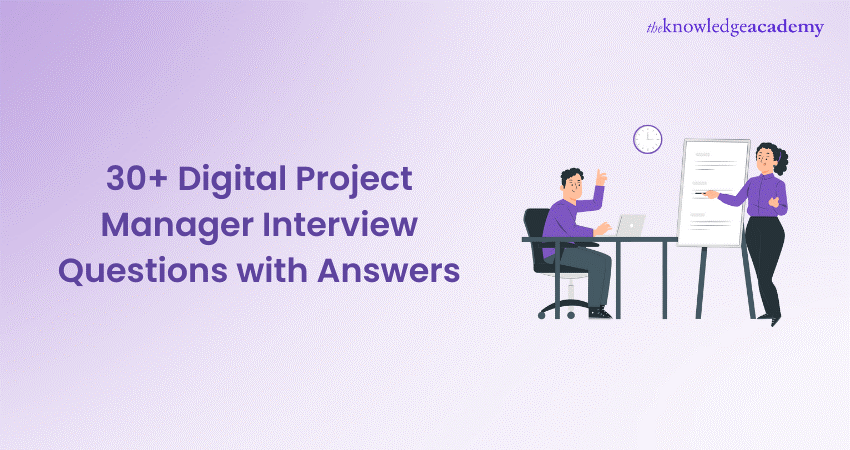
To become a successful Digital Project Manager, you must face some of the most crucial Digital Project Manager Interview Questions. These questions will help the interviewer determine what kind of candidate you are and how you handle stressful situations efficiently.
These questions will also allow the interviewers to understand how you handle stressful and unforeseen situations and manage tight deadlines. Read this blog to learn how to answer Digital Project Manager Interview Questions and stand out from the crowd.
Table of Contents
1) Commonly asked Digital Project Manager Interview Questions and answers
a) Give some examples of Project Management software.
b) What are some crucial qualities essential to becoming a Digital Project Manager?
c) How do you maintain the workflow of a project and ensure that it meets deadlines?
d) Do you have any experience with managing remote teams?
e) Can you tell me when you dealt with a difficult client or customer?
f) If hired, how will you learn about our company and its goals?
g) How would you handle a situation if a team member submitted their work late?
h) What steps do you take to handle stress while managing multiple projects simultaneously?
i) Do you have any questions about the role or our company?
j) When do you start your day as a Digital Project Manager?
2) Conclusion
Commonly asked Digital Project Manager Interview Questions and answers
Let’s discuss some commonly asked Digital Project Manager Interview Questions, along with answers, to help you crack your next interview:
1) Give some examples of Project Management software.
Answer: You can use this sample answer: “Several Project Management software tools are pivotal in Digital Project Management. These tools help facilitate project planning, resource allocation, team collaboration, and progress tracking. Prominent examples include Asana, which offers versatile project tracking and collaboration features.
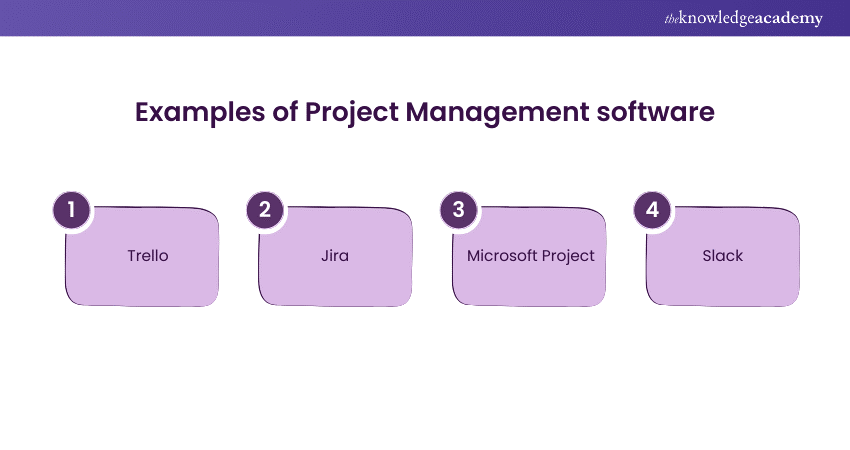
Trello is known for its Kanban-style Task Management; Jira is highly favoured in software development for its Agile Project Management capabilities. Microsoft Project offers comprehensive project management and planning tools. Slack, while primarily a communication tool, integrates with various Project Management apps for seamless team collaboration.
These tools vary in functionality, catering to different project sizes and complexities, making it essential for a Digital Project Manager to select the most suitable one based on the project’s specific needs.”
2) What are some crucial qualities essential to becoming a Digital Project Manager?
Answer: You can answer this question in this way: “Yes. Certain qualities are essential to excel as a Digital Project Manager. Communication skills are critical for effectively conveying project goals, updates, and feedback among team members and stakeholders. Organisational skills enable the management of multiple tasks and deadlines efficiently. Leadership and teamwork abilities are essential for motivating the team, fostering collaboration, and resolving conflicts.
Adaptability is crucial in the fast-paced digital environment to manage changing project scopes, technologies, and market demands. Lastly, problem-solving skills are necessary to anticipate challenges and devise practical solutions promptly. These qualities and a strong understanding of Digital Project Management principles set the foundation for successful project delivery.”
3) How do you maintain the workflow of a project and ensure that it meets deadlines?
Answer: You can use this sample answer: “Maintaining a project's workflow and ensuring timely completion involves strategic planning and continuous monitoring. I define clear project objectives, deliverables, and timelines through a detailed project plan. This plan is communicated to all team members to align expectations.
I use different Project Management tools to assign several tasks, set deadlines, and track the project's progress. Regular team meetings and check-ins help identify any bottlenecks or delays early on. I also prioritise tasks based on urgency and impact, adjusting resources to keep the project on track. Risk Management strategies are employed to anticipate and mitigate potential issues before they impact the schedule. I foster a culture of accountability and provide support where needed. I ensure that the project progresses smoothly towards its deadlines.”
4) Do you have any experience with managing remote teams?
Answer: You can answer this question in this manner: “Yes, I have extensive experience managing remote teams, which has become increasingly relevant in today’s Digital Project Management domain.
This experience taught me the importance of clear communication, trust, and flexibility. I leverage various communication and collaboration tools to ensure team members are aligned with the project goals and tasks.
Regular video calls and virtual team meetings help maintain a sense of connection and team spirit. I set clear expectations regarding deliverables and deadlines while offering flexible working hours to accommodate different time zones and personal work preferences.
Building a culture of accountability and trust is crucial, as is providing continuous support and feedback. Managing remote teams has also honed my ability to adapt to diverse working styles and leverage team members' unique strengths to achieve project success.”
5) Can you tell me when you dealt with a difficult client or customer?
Answer: You can use this as your sample answer: “In my experience, I encountered a challenging situation with a client unsatisfied with the initial project deliverables, citing discrepancies with their expectations.
Recognising the importance of client satisfaction, I promptly arranged a meeting to discuss their concerns. Listening actively to their feedback, I identified the critical areas of concern and proposed a revised plan to address these issues, ensuring it aligned with their expectations.
I maintained transparent communication throughout the revision process, involving the client in critical decisions to rebuild trust and confidence in our team. This approach resolved the immediate issue and strengthened our relationship with the client, leading to future collaborations. It taught me the value of empathy, clear communication, and a proactive approach to managing client relationships.”
6) If hired, how will you learn about our company and its goals?
Answer: You can use this answer: “Upon joining the company, my initial step would be to immerse myself in understanding the company’s vision, culture, and goals. I would request meetings with key stakeholders, including management, team leads, and colleagues, to gain insights into the company’s strategic objectives, ongoing projects, and challenges.
Reviewing past project documentation and performance reports would also provide valuable context. Additionally, I plan to engage with the company’s products or services firsthand to better understand the customer experience and areas for improvement.
Participating in company training sessions and workshops will further enhance my understanding of the company’s processes and standards. This comprehensive approach will enable me to effectively align my Project Management strategies with the company’s goals, contributing to its success.”
7) How would you handle a situation if a team member submitted their work late?
Answer: You can answer this question in this manner: “Handling late submissions involves addressing the immediate issue and implementing strategies to prevent future occurrences. Initially, I would have a one-on-one discussion with the team members to understand the reasons behind the delay, offering support and solutions if they face any obstacles. It's essential to communicate the impact of late submissions on the project and team morale.
Depending on the situation, I might adjust project timelines or redistribute tasks to mitigate the delay's effect. I would review and possibly refine the project’s workflow to prevent future issues, ensuring that expectations and deadlines are clear and manageable.
Implementing regular check-ins and progress tracking can help identify potential delays early. Encouraging an open communication culture ensures team members feel comfortable seeking help before missing deadlines.”
8) What steps do you take to handle stress while managing multiple projects simultaneously?
Answer: You can use this sample answer: “Managing stress while juggling multiple projects is crucial for maintaining productivity and well-being. I prioritise tasks across projects based on urgency and impact, focusing on what needs immediate attention while planning for less critical tasks.
Effective Time Management and delegation are essential; I trust my team with responsibilities, empowering them to take ownership of their tasks. Utilising Project Management tools helps me keep an organised overview of all projects, allowing for efficient tracking and adjustments as needed.
Regular breaks and mindfulness practices, such as meditation or short walks, help me maintain mental clarity and reduce stress. Maintaining a healthy work-life balance is essential, allowing me to recharge and approach challenges with a fresh perspective.
Additionally, open communication with my team and stakeholders about current workloads and realistic timelines helps manage expectations and alleviate pressure.”
9) Do you have any questions about the role or our company?
Answer: You can answer this question in this way: “As a step in understanding the company and role better, I have a few questions:
a) What are the short-term and long-term goals of the department I will join?
b) Can you describe the company culture and how the organisation supports professional development?
c) How does the company measure success for digital projects, and what are the key performance indicators?
d) Could you share insights into the typical challenges the Digital Project Management team faces and how the company addresses them?
e) What are the opportunities for growth and advancement within the role and the company? “
10) When do you start your day as a Digital Project Manager?
Answer: You can answer this question in this manner: “My day as a Digital Project Manager typically starts early, around 7:30 AM. Beginning the day before the core working hours allows me to plan and prioritise tasks without immediate pressure.
I review my emails and messages to address any urgent communications from team members or stakeholders across different time zones. Following this, I review the project schedules and to-do lists to adjust priorities based on new developments or deadlines.
This time is also used for strategic planning and critical thinking, laying out the day's goals and identifying potential challenges. Before the team starts their day, I ensure I have a clear action plan, enabling me to provide direction and support effectively as they come online. This routine helps maintain a proactive approach to Project Management, ensuring smooth operations and timely responses to any issues that arise.
Do you want to learn about Project Management? Register now for our Project Management Courses.
11) Do you have any points on how we can improve the features of our website?
Answer: You can add to this sample answer: “Improving website features requires a comprehensive approach that starts with understanding user needs and business goals. Conducting a thorough analysis using tools like user feedback, heat maps, and analytics can identify areas for improvement.
For example, enhancing User Experience (UX) through intuitive navigation, faster load times, and responsive design can significantly increase user engagement and satisfaction.
Incorporating Search Engine Optimisation (SEO) best practices will improve visibility and drive more traffic. Regularly updating content and adding interactive elements, such as chatbots for customer support, can also enhance user engagement.
Additionally, ensuring the website is accessible to all users, including those with disabilities, can broaden your audience and demonstrate social responsibility. Implementing these changes requires a strategic plan that prioritises updates based on impact and aligns with the company's goals.
This helps in ensuring the website not only meets but exceeds user expectations and supports business growth.”
12) What steps do you take to set goals for a new project?
Answer: You can use this sample answer: “Setting goals for a new project involves a structured approach to ensure clarity, relevance, and achievability. Initially, I engage with stakeholders to understand their vision, requirements, and expectations. This collaboration helps align the project objectives with the organisation's strategic goals.
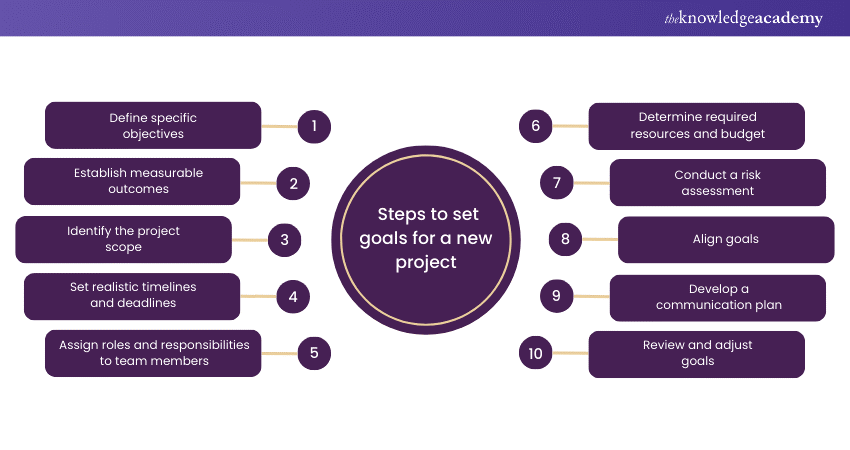
I conduct a Strengths, Weaknesses, Opportunities, and Threats Analysis (SWOT) to provide insights into the project's potential and challenges. Based on this information, I formulate Specific, Measurable, Achievable, Relevant, and Time-bound goals (SMART) to provide a clear roadmap for the project. Establishing these goals involves considering resources, timelines, and constraints to ensure they are realistic and attainable.
Once defined, these goals are communicated to the project team to ensure everyone is aligned and understands their role in achieving them. Regular review and adjustment of these goals are necessary to respond to any changes or challenges encountered during the project lifecycle.”
13) How are you different from other candidates interviewing for this role?
Answer: You can add more to this sample answer: “My unique value proposition as a Digital Project Manager lies in my combined experience in technology, business strategy, and Team Leadership.
My proven track record of successfully managing complex digital projects across diverse industries sets me apart. It has equipped me with a deep understanding of digital trends and User Experience best practices.
My highly collaborative approach emphasises stakeholder engagement and team empowerment to foster innovation and drive project success. I bring a strong analytical mindset, allowing me to navigate challenges and optimise project outcomes effectively.
My commitment to continuous learning and adaptation ensures that I stay ahead in a rapidly evolving digital landscape, making me an asset to any team seeking to meet and exceed their project goals.”
14) What Project Management methods do you use the most?
Answer: You can answer this question in this manner: “I predominantly use Agile and Scrum methodologies for managing digital projects due to their flexibility, adaptability, and focus on customer value. With its iterative approach, Agile methodology allows continuous feedback and improvement, ensuring the final product closely aligns with user needs.
Scrum, a framework within Agile, facilitates short sprints of work with regular check-ins, enabling teams to adjust quickly to project changes while maintaining momentum. This approach promotes transparency, encourages team collaboration, and enhances productivity.
Additionally, I integrate Lean principles to streamline processes, eliminate waste, and optimise resources. This combination of methodologies allows me to manage project timelines, budgets, and scope effectively while ensuring high-quality deliverables and stakeholder satisfaction.”
15) How can you, as a Digital Project Manager, help your team to succeed?
Answer: You can answer this question in this manner:” As a Digital Project Manager, my role in facilitating team success involves creating a supportive and collaborative environment where each member can thrive. I clearly define roles, responsibilities, and expectations to ensure alignment and accountability.
Effective communication is critical; therefore, I will establish regular meetings and updates to keep my team informed and engaged. Providing my team with the essential tools and resources, including training and development opportunities, empowers them to perform their best. I also prioritise fostering a feedback culture where constructive criticism and recognition are freely shared to encourage growth and improvement.
By actively removing roadblocks and facilitating problem-solving, I ensure the team can maintain focus on their tasks. My Leadership style emphasises trust, respect, and empathy, enabling a positive work atmosphere that drives motivation and productivity.”
16) How many times do you update project plans?
Answer: You can add more to this sample answer: “Project plans are dynamic documents that require regular updates to accurately reflect a project's present state. The frequency of updates generally depends on the project phase, complexity, and the occurrence of significant events or changes.
I review and update project plans bi-weekly during regular project execution phases to ensure they remain aligned with project goals and timelines. During critical phases or when facing unexpected challenges, updates may be more frequent, possibly weekly or even daily, to manage risks and make necessary adjustments promptly.
Regular updates ensure that all stakeholders are informed of the project's progress and any deviations from the plan, enabling timely decision-making and keeping the project on track towards its objectives.”
17) How do you handle conflict between two team members?
Answer: You can use this as your sample answer: “Handling conflict between team members involves a careful and empathetic approach to restore harmony and collaboration. Initially, I encourage open and direct communication between the parties involved, facilitating a safe environment for them to express their viewpoints and concerns.
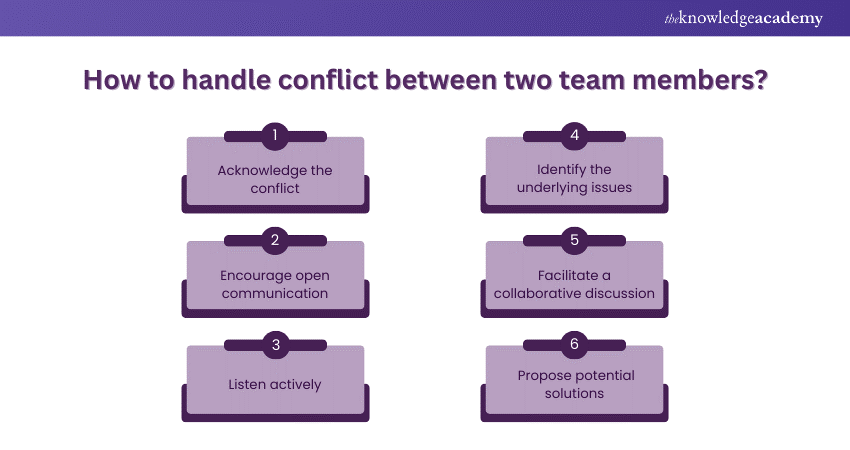
Active listening and mediation help identify the conflict's root cause and understand each party's perspective. From there, I work with them to find a mutually acceptable solution, focusing on the problem rather than personal attributes.
Establishing clear guidelines for professional conduct and communication within the team can prevent future conflicts. It’s important to address conflicts promptly to avoid escalation and to maintain a positive team dynamic, ensuring that resolution efforts are constructive and focused on fostering understanding and respect among team members.”
18) Do you have any experience with budgeting and Cost Management?
Answer: You can answer this question in this way: “Yes, I have extensive experience in budgeting and Cost Management for digital projects. My expertise involves planning project budgets based on detailed cost estimates, including resources, technology, personnel, and other expenses.
I closely monitor project expenditures against the budget throughout the project lifecycle, implementing cost-tracking mechanisms and financial reporting to ensure transparency and accountability.
Regular reviews allow me to identify variances and take corrective actions, such as reallocating resources or adjusting project scope, to keep the project within budget. Effective Cost Management also involves risk assessment to anticipate and mitigate potential overruns. My goal is always to deliver projects that meet or exceed expectations while adhering to the allocated budget, ensuring financial efficiency and sustainability.”
19) How do you inform all stakeholders about a project's progress?
Answer: You can use this as your sample answer: “Keeping stakeholders informed about project progress is crucial for transparency and engagement. I communicate updates effectively using a combination of regular status reports, meetings, and digital dashboards. Status reports, tailored to the interest and level of detail required by each stakeholder group, provide a comprehensive overview of project milestones, achievements, challenges, and next steps.
Regular in-person or virtual meetings offer an interactive platform for discussing project updates, addressing concerns, and gathering feedback. Digital dashboards provide real-time visibility into project metrics, allowing stakeholders to track progress conveniently.
This multi-faceted communication strategy ensures that all stakeholders are informed and engaged, fostering a collaborative relationship and aligning expectations throughout the project lifecycle.”
20) What aspects of Digital Project Management do you believe you could further develop or enhance?
Answer: You can use this as your sample answer: “I am particularly keen on enhancing my expertise in Data Analytics and Predictive Analysis to forecast project outcomes better and make data-driven decisions. Further developing my skills in these areas would enable me to identify trends, anticipate risks, and optimise resources more effectively.
Additionally, I aim to deepen my understanding of current technologies, such as AI and Machine Learning, to explore innovative solutions and improve project efficiency. Strengthening my Leadership skills, especially in fostering diversity and inclusion within project teams, is another area of focus, as diverse perspectives drive creativity and innovation.
Continuous learning and adaptation are crucial to staying ahead in Digital Project Management, ensuring that I can lead teams to navigate the challenges of the Digital industry successfully.”
21) How do you maintain Quality Control throughout a project's lifecycle?
Answer: You can use this sample answer: “To ensure Quality Control throughout a project, I implement a rigorous quality assurance process from the outset. This involves defining clear quality standards and criteria in alignment with the project objectives and stakeholder expectations. I integrate regular quality checks and reviews at each phase of the project, involving both internal team members and, when appropriate, external quality assurance specialists.
Utilising checklists and quality metrics, I ensure that all deliverables meet the predefined standards before proceeding to the next stage. Feedback loops are essential, enabling the incorporation of feedback to improve quality continuously.
This proactive approach to Quality Control helps identify and rectify issues early, ensuring the final output meets the highest standards. “
22) What is your method for resolving technical issues that occur during a project?
Answer: You can add more to this sample answer: “When troubleshooting technical issues, my approach is systematic and analytical. First, I gather as much information as possible about the problem, including the symptoms, conditions under which it occurs, and any changes that might have triggered it. Collaborating with the technical team, we brainstorm potential causes and test hypotheses systematically until we identify the root cause.
Utilising my technical knowledge and leveraging the expertise within my team, I prioritise finding efficient solutions and minimise disruption to the project timeline. Keeping stakeholders informed about the issue and the steps taken to resolve it is crucial for maintaining transparency and trust. “
23) How do you ensure effective communication among team members?
Answer: You can add more to this sample answer: “Effective communication within the team is fostered by establishing clear channels and protocols for information sharing. I promote an open communication culture where team members feel valued and heard, encouraging regular meetings and updates that allow for the free exchange of ideas and feedback.
Collaboration tools like Slack or Microsoft Teams enable real-time communication and easy sharing of documents and updates. I also emphasise the importance of active listening and ensure that all communication is clear, concise, and accessible to everyone involved, regardless of their role or location. “
24) How do you manage client feedback and change requests during a project?
Answer: You can add more to this sample answer: “Managing client feedback and change requests involves balancing flexibility and adherence to project scope and objectives. I welcome client feedback as an excellent opportunity to improve and align the project closer to their vision. I assess the desired impact on the project scope, timeline, and budget upon receiving feedback or change requests.
I then discuss the implications with the client, offering alternative solutions if necessary to meet their needs while maintaining project integrity. Transparent communication and negotiation skills are vital to finding mutually satisfactory solutions that honour the project’s constraints and the client’s expectations.”
25) What methods do you employ to monitor project milestones and deadlines?
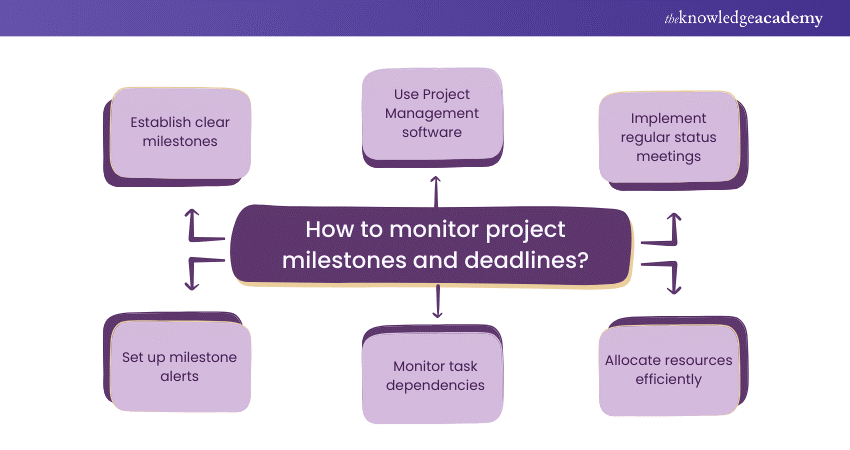
Answer: You can use this as your sample answer: “To track project milestones and deadlines, I heavily rely on Project Management tools like Asana or Microsoft Project, which visually represent the project timeline and critical milestones. Setting up automatic reminders and updates helps keep the team aware of upcoming deadlines.
Regular progress reviews with the team enable us to assess our advancement towards the milestones and make necessary adjustments to keep the project on track. This systematic approach ensures that we remain aligned with the project plan and can proactively address any delays.”
26) Can you share your experiences with Project Management tools such as Asana, Trello, and Basecamp?
Answer: You can add more to this sample answer: “My experience with Project Management tools like Asana, Trello, and Basecamp has been integral to successfully managing digital projects. I find that Asana is particularly useful for task assignments and timelines, Trello offers an excellent visual overview for managing project workflows, and Basecamp facilitates effective team communication and document sharing.
I've leveraged these tools to streamline collaboration, improve project visibility, and keep tasks organised and on track. My familiarity with these platforms enables me to choose the tool which fits best, based on the project's specific needs and team preferences.”
27) How do you stay organised while handling several projects simultaneously?
Answer: You can add this as your sample answer: “Staying organised with multiple projects demands a structured approach and effective Time Management. I use a good combination of Project Management software and personal organisation tools to keep track of deadlines, priorities, and tasks across projects.
Prioritising tasks based on urgency and impact, setting clear goals for each day, and allocating specific time blocks for focused work on each project help me maintain control and progress evenly across projects. Regular reviews allow me to adjust plans and ensure nothing falls through the cracks.”
28) What strategies do you use to keep your team motivated and focused on their objectives?
Answer: You can use this as your sample answer: “To keep my team motivated and focused, I ensure that each member understands the project's goals and their role in achieving them. I set clear, achievable objectives and celebrate milestones to recognise progress and hard work. Encouraging autonomy and providing opportunities for professional growth fosters a sense of ownership and satisfaction.
Regular feedback and open communication help address any concerns and keep morale high. I also strive to create a positive work environment that values teamwork and collaboration, where everyone feels supported and motivated to contribute their best.”
29) How do you manage unexpected delays or obstacles in a project?
Answer: You can use this as your sample answer: “When facing unexpected delays or obstacles, I first assess the situation to understand the impact on the project timeline and deliverables. Communication is key; I inform stakeholders about the issue and the proposed steps to address it.
I then work with the team to brainstorm solutions, re-prioritise tasks, and adjust the project plan to mitigate the impact of the delay. Staying flexible and maintaining a problem-solving attitude helps navigate these challenges while keeping the project on course.”
30) What are your strategies for identifying and mitigating potential risks in a project?
Answer: You can add more to this sample answer: “Identifying and mitigating potential risks involves a proactive risk assessment approach throughout the project lifecycle. I conduct a thorough risk analysis during the planning phase, engaging the team and stakeholders to identify possible risks based on their expertise and past experiences.
For each identified risk, I develop a mitigation plan, outlining strategies to prevent it from occurring or reduce its impact if it does. I regularly review and update the Risk Management plan to ensure that new risks are promptly addressed and that the project remains resilient in the face of potential challenges.
31) How do you motivate your team and maintain their focus on project goals?
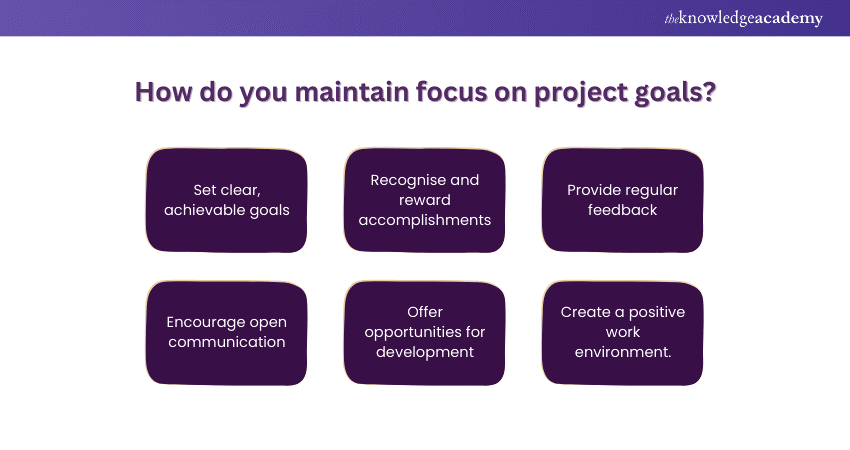
Answer: You can use this as your sample answer: “Motivating my team involves recognising their efforts, providing constructive feedback, and developing a supportive environment where each member can thrive. I emphasise the importance of the project's success to the organisation and their personal and professional growth.
Setting achievable goals and regularly reviewing progress helps maintain focus and momentum. I encourage open communication and collaboration, creating a team culture where all team members feel valued and motivated so that they can contribute to our shared objectives.
Become a Certified Global Project Manager with our Certified Global Project Manager Course! Sign up now!
Conclusion
We hope that from this blog, you understand how you can answer some of the most crucial Digital Project Manager Interview Questions and stand out from other candidates. The answers in the blog will help you form your answer when you practice mock interviews so that you are ready for your subsequent interviews.
Do you want to learn the fundamentals of Project Management? Register now for our Project Management Office Fundamentals Certification Course!
Frequently Asked Questions
Upcoming Project Management Resources Batches & Dates
Date
 CDSPM (Certified Digital Services Project Manager) Course
CDSPM (Certified Digital Services Project Manager) Course
Thu 29th Aug 2024
Thu 21st Nov 2024
Thu 6th Mar 2025
Thu 12th Jun 2025
Thu 11th Sep 2025
Thu 4th Dec 2025







 Top Rated Course
Top Rated Course



 If you wish to make any changes to your course, please
If you wish to make any changes to your course, please


